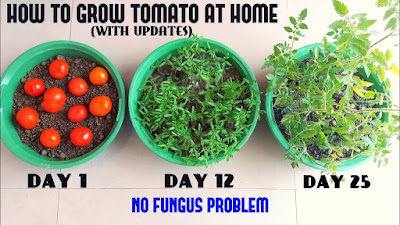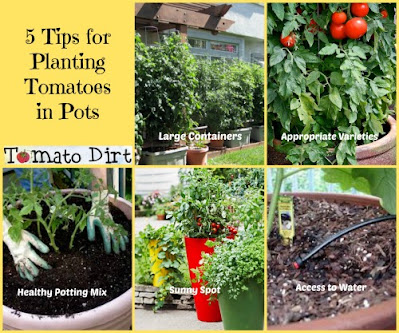Growing Tomatoes in the Home Garden
'
The problem is people who can't grow a yard full of decent grass think they can grow an acre full of excellent tomatoes!' Jake Vest, humorist.
By Judy Sedbrook, master gardener, Colorado State University Cooperative Extension, Denver County
Are you watching the snow fall and dreaming about summer and all of the tasty things that come with it? By following a few basic guidelines, you can easily and sucessfully grow the tomatoes for a summer salad or BLT' in your own garden.
The tomato plant is a tender, warm-season perennial that is treated as an annual for growing in summer and fall gardens. They will be ready to harvest in about 60 days from planting and just a few plants will provide enough tomatoes for most families.
According to the U.S. Department of Agriculture, four out of five people prefer tomatoes to any other homegrown food. Biologically a fruit, they are the most popular "vegetable" grown by American gardeners. Because they are eaten in such quantity, tomatoes rank number one in contributing nutrients to the American diet.
Native to South America, the tomato was grown by the Aztecs and eaten mixed with chilies and other vegetables.
The Spanish conquistadors took the seeds back to Europe with them in the early 1500s and the tomato flourished in the Mediterranean area.
The genus name of the tomato, Lycopersicon, means "wolf peach". This name arose from the belief in most of the rest of Europe that the tomato, a member of the nightshade family, was poisonous. By the mid-eighteenth century, the tomato was generally accepted throughout all of Europe and was given the species name of esculentum, meaning edible.
Brought back to this continent by the early American colonists, the tomato was initially grown by avid gardeners such as Thomas Jefferson and became widely cultivated only after 1830.
LOCATION:growing tomatoes in pot (139617 bytes)
Chose your garden site carefully. Avoid microclimates that may be too cold at night or too hot during the day.
The ideal garden for tomatoes receives full sun most of the day, is protected from the wind, has well-amended soil and is near a convenient water source.
Raised beds are a good place to grow tomatoes. They require fewer pathways, leaving more space for growing. This method of gardening requires less fertilizer and compost and the soil doesn't become compacted from being frequently stepped on.
Tomatoes also do well as container plants but will require more frequent watering.
SOIL:
Tomatoes need rich, well-drained soil.
The soil should be amended with organic matter, compost or a tilled-in cover crop such as rye, wheat, oats, or hairy vetch before planting season. A complete fertilizer that is not too high in nitrogen should also be added prior to planting. Too much nitrogen will produce large plants but few tomatoes.
If you have grown tomatoes before, rotate your new crop to a spot where they have not been planted in at least the last four years.
VARITIES:
Tomato plants available for purchase are usually hybrids of popular types including Celebrity, Early Girl, Big Boy, Fantastic, and Big Beef. For less common selections, seeds of many varieties are available from seed catalogues.
Varieties recommended for this area are Big Boy, Good-n-Early, Lemon Boy, Spirit, and Yellow Stuffer.
STARTING FROM SEED:
Using a sterile, soil-free potting mixture, start tomatoes indoors six to eight weeks before the frost-free date (May 15th in our area). Germination will take 7 to 14 days at 75° to 80° F. Give the plants as much light as possible, either in a south window, or for more uniform results, under artificial grow-lights for at least 14 hours a day.
As the seedlings grow, transplant them into larger and larger containers, each time burying the whole stem below the first set of leaves. The tomatoes will send out roots from the buried stem and will have developed a strong root system by the time they are ready to be planted outdoors.
Move your seedlings outdoors for a few hours each afternoon to get them acclimated, or hardened-off, before actually planting them in the garden.
TRANSPLANTING:
After the danger of frost is past and temperatures are consistently above 50° F at night and 65°F during the day, transplant your tomatoes into the garden. Space them as directed on seed packets or plastic inserts. You can get a head start on the season by planting outdoors earlier and using Wall O'Water or other such season extenders.
If purchasing tomato plants from a nursery or garden center, be sure to get high quality, semi-hardened transplants. Avoid tall, spindly plants. A good transplant should be as wide as it is tall, have a stem that is as thick as a pencil, and dark green foliage. It is preferable to get plants without blossoms or fruit. If blossoms or fruit are present, pinch them off to prevent a delay in vegetative growth and flowering.
To minimize chemical use, be sure to purchase disease-resistant varieties.
Take care when removing the plants from flats or pots. Damaged root systems will delay growth of the plant. If the transplant has a long stem, "trench" it in by burying the stem laterally. This buried portion of stem will then send out roots.
Plant each tomato deeper than it was growing in its pot, burying it up to within three or four branches from its top. Firm the soil around the plant and water lightly. Planting within a shallow collar made from tin cans or toilet paper rolls will discourage cutworms.
You may want to use a floating row-cover to protect the young plants from wind, sun, temperature fluctuations and flying insects. Once the tomato plants are established, you can remove the row covers and support the plants with cages or by staking. Supporting the plants helps to keep the fruit off of the ground, reducing damage from ground rot and slugs.
MULCH:
After the soil warms up completely, mulch your plants with commercial plastic or fabric, bark, straw or dried grass clippings. The mulch should be several inches deep and close to the plants. This will help to control weeds, keep soil temperature constant, reduce water loss, and keep the fruit clean.
WATER:
Apply water at regular intervals, soaking to a depth of 8-10 inches to keep the soil uniformly moist. Avoid fluctuations that may cause blossom drop, blossom end rot, or cracked fruit. Continue to water regularly until late August, avoiding prolonged wilting. After this time, fruit will ripen more quickly when water is withheld.
FERTILIZER:
Fertilize seedlings weekly with a liquid fertilizer, such as a seaweed/fish emulsion mix , using one ounce of fertilizer to one gallon of water. Or you may want to try one of the commercial water-soluble fertilizers available, such as Rapid Gro or Miracle Grow, for example. After plants are well established, continue to provide additional fertilization every week to 10 days. Discontinue fertilizing after the first part of August because it will induce vine growth at the expense of ripening the fruit.
HARVEST:
Harvest mature green tomatoes in the fall before a killing frost is expected. Wrap the green fruit individually in newspaper and store in a cool place (60° to 65° F). Unwrap and allow ripening in a window as needed. Immature green tomatoes may be harvested and used for frying or making jams, relishes or pickles.
Once the tomato plants have become established, there is little else to do but sit back and relax, open your cookbook and begin planning what to do with the harvest.
Growing Tomatoes in the Home Garden Video:


